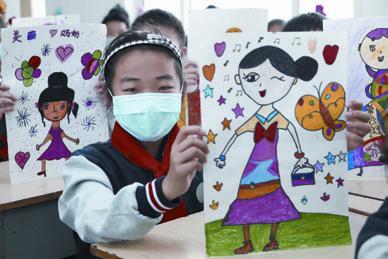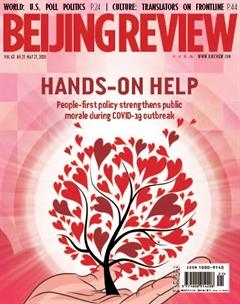A HEAD FOR HEIGHTS

A team of surveyors returns to the advanced base camp of Mount Qomolangma, the highest peak in the world, in Tibet Autonomous Region, southwest China, on May 12, to dodge bad weather and the risk of snowslides.
Chinese surveyors started remeasuring the height of the mountain on April 30 for an update as the mountain grows when snow accumulates on the summit and shrinks when it melts.
China has conducted six rounds of measurement and scientifi c research on Mount Qomolangma since 1949. The last one in 2005 determined the height to be 8,844.43 meters.

Images of Love
Primary school students in Lianyungang, a city in Jiangsu Province in east China, show on May 9 the paintings they did of their mothers to celebrate Mothers Day, May 10.
Swine Fever
China is making headway in containing African swine fever, with cases of the disease dwindling since late 2018.
No major regional outbreak of the animal disease has occurred since August 2018, when the fi rst case was confi rmed in the northeastern province of Liaoning, Han Changfu, Minister of Agriculture and Rural Affairs, said at a video conference on May 12.
Han added that the number of reported cases also showed a downward trend.
Hog production recovery has gained momentum. The number of breeding sows in stock increased in the past three months and the prices of live pigs went down for 12 consecutive weeks, he said.
To continue stabilizing hog production and pork prices, the minister urged local departments to tighten monitoring, enhance regular disease control and optimize oversight of each link.
Coupon Incentive
The northern port city of Tianjin will distribute coupons worth more than 60 million yuan ($8.46 million) to stimulate consumption, local authorities said on May 12.
Coupons worth 21 million yuan ($3 million) have already been issued. They are for use in catering, cars, home appliances and building materials businesses, according to the Tianjin Commission of Commerce.
The city will provide enterprises, which have online stores on major shopping platforms such as Tmall, JD.com and Suning.com, with fi nancial subsidies to reduce their annual fees and commissions.
Many cities, including Nanjing in Jiangsu Province in east China and Ningbo in Zhejiang Province, also in the east, have launched coupons to encourage residents to dine out and shop to boost consumption hit hard by the novel coronavirus.
Game Expo
ChinaJoy, Asias biggest game event held annually in Shanghai, will start on July 31 as scheduled, its organizing committee announced.
The four-day exhibition will be held both online and offl ine. All the preparatory work is going smoothly, the organizing committee told an online press conference on May 11.
It will launch new programs such as a Global Cloud-Game Industry Conference and a Fashion Toy Exhibition. Also known as the China Digital Entertainment Expo and Conference, the exhibition received 364,700 gamers last year.
China has become the worlds largest online game market. Statistics show that the market size hit 231 billion yuan ($32.6 billion) in 2018, and is expected to reach 300 billion yuan ($42.3 billion) in 2020.
Canton Fair
The 127th China Import and Export Fair, also known as the Canton Fair, will exempt exhibition fees for enterprises, according to the Ministry of Commerce (MOFCOM) on May 10.
Exhibition fees will be waived to cope with the impact of the epidemic and help foreign trade enterprises expand market and tide over diffi culties.
Cross-border e-commerce platforms that participate will also be exempt from fees.
MOFCOM lowered exhibition fees for the Canton Fair for many sessions to relieve pressure on fi rms and exempted booth fees for enterprises from poverty-stricken areas in recent years, saving over 2 billion yuan ($283 million) for enterprises.
The 127th Canton Fair will be held online from June 15 to 24.
Rural Development
A guideline to promote digital technologies in rural areas has been released to advance agricultural and rural modernization.
Issued by four government departments including the Ministry of Agriculture and Rural Affairs, it details measures to support the use of information technology in epidemic control, as well as economic and social development in rural areas.
It encourages the use of technologies like big data, artif ciial intelligence (AI), and remote intelligent agricultural machinery, and online services in areas such as spring farming, vocational training and recruitment of migrant workers.
It also highlights the construction of new infrastructure in rural areas, including expanding the broadband and 4G network, improving Internet access for schools, upgrading power grids and promoting smart water conservancy projects.
Digital technologies are recommended to promote inclusive fi nance in rural areas.
Publishers Webinar
Representatives from the global publishing community explored ways of coping with the COVID-19 pandemics repercussions on their industry at a webinar on May 11.
While COVID-19 has taken a toll on book publishing and distribution, smart technology is gaining traction, Lu Cairong, Vice President of the China International Publishing Group (CIPG), said.
CIPG, a Beijing-based Chinese publishing conglomerate targeting international readers, has been building a cyber presence by hosting online events. Publishers from nine countries including China, the United States and Germany took part in the webinar. CIPG has previously held a virtual book launch and marketed some of its titles through live-streaming.
“It is heartening to see that China has overcome this disease,”said Mohan K. Kalsi, Chairman of the BKM RoyalCollins Publishers Private Limited, the New Delhibased Indian branch company of Royal Collins.
Kalsi told Beijing Review that BKM RoyalCollins has translated a book by Zhang Wenhong, an outspoken doctor from Shanghai who had led a team of medical experts fi ghting the epidemic in Wuhan since January, into Hindi and plans to launch it this month.
As part of its efforts to bolster the publishing industry and counter the impact of the pandemic, CIPG will stage an international book fair online in mid-July.

Passing the Baton
Teachers put nurses caps on students majoring in nursing at a vocational school in Nantong, a city in Jiangsu Province in east China, on May 10. The ceremony was held before the statue of British nurse Florence Nightingale, who is regarded as the foundational philosopher of modern nursing. International Nurses Day, marked on May 12, commemorates her birth and celebrates the important role of nurses in healthcare.
Learning Chinese
A global Chinese language learning platform has recorded more than half a million users worldwide.
As of May 6, the platform, iFLYChinese, had attracted 576,000 users from 123 countries and regions, according to iFLYTEK Co. Ltd., a leading Chinese AI company that developed the app. The platform uses AI-based technology to reach out to learners at home and abroad. Learners are assigned personal AI tutors, which can correct their pronunciation and give personalized feedback and exercise cards for memory-enhancing learning activities.
The platform also features a collection of Chinese poetry, classical literature and calligraphy masterpieces in audio and video to help the users understand Chinese culture.

Museum Reopens
Tourists at the Palace Museum on May 1. The museum, also known as the Forbidden City, reopened after it was closed on January 25. Visitors need to make reservations online, wear masks and have their body temperatures checked before admission. There is a daily cap on the number of visitors.
Passenger Cars
Sales of passenger cars in China continued to warm up in April as pent-up demand was unleashed, but the foundation for a “V-shape”rebound is yet to solidify due to the lingering uncertainties caused by the impact of the novel coronavirus disease (COVID-19) epidemic, industry data showed on May 11.
The retail sales of passenger vehicles amounted to 1.43 million units in April, down 5.6 percent year on year but recovering from the 40-percent drop in March and 79-percent fall in February, according to the China Passenger Car Association (CPCA).
Passenger car sales surged 36.6 percent month on month, reversing the usual seasonal trend and suggesting a relatively quick recovery in demand following further domestic containment of the epidemic.
While the overseas spread of the virus may have affected consumer confi dence, pent-up demand combined with consumption-stimulating policies have offset the negative impacts, the CPCA noted, adding that the slump in international oil prices also played a part.
Sales of new energy passenger cars came in at 64,000 units in April, down 30 percent year on year but up 14.8 percent from March.
To cushion the short-term impact of the epidemic outbreak on auto sales, a pillar of Chinese consumption, the Chinese Government has encouraged local authorities and fi nancial institutions to roll out measures to help stimulate the market.
Fund Custody
The China Securities Regulatory Commission (CSRC) is mulling over supporting foreign banks to gain access to fund custody service in the Chinese market, a move to further open up the fi nancial sector, according to a revised draft of fund custody rules issued by the countrys top securities regulator.
Eligible domestic branches of foreign banks would be able to apply for permit to conduct fund custody business, according to the draft circulated for public comments by the CSRC.
Besides general entry requirements, applicant branches for the permit should have been in operation for at least three years with good performance and asset quality, as well as enough working capital to match the scale of the planned fund custody business, according to the draft.
As for fi nancial performance requirements such as net assets, which were revised down to 20 billion yuan ($2.82 billion) in the new version, the draft suggested using the performance indicators of the applicants headquarters overseas.
The draft also improves regulatory oversight of fund custodian banks to stem risks through ways including having the headquarters of foreign banks bear civil liability for their Chinese branches, as well as specifying requirements on cross-border information system deployment and cross-border fl ow of data.
The revision marks a further step in Chinas fi nancial opening-up to further boost foreign banks participation in the Chinese securities and fund market, Shanghai Securities News reported, citing remarks from HSBC Bank (China), which is looking forward to gaining access to the fund custody business in the domestic market.
Liao Zhiming, an analyst with Tianfeng Securities, said the move is unlikely to impact the domestic banking sector. It will encourage benign competition and bring in more funds to the capital market.

Accelerating Construction
Staff work at the construction site of the intercity railway between the Zhengzhou Xinzheng International Airport and the Zhengzhou South Railway Station in Zhengzhou, Henan Province in central China, on May 10. The project is scheduled to be completed by the end of this year.
Tax Reduction
A new survey by China Youth Daily found that 58.6 percent of respondents supported the rollout of tax and fee reduction measures to ease strains on fi rms and help mitigate the impact of the COVID-19 epidemic.
The survey covered 2,015 people, 26.9 percent of whom live in fi rst-tier cities, 48.4 percent in second-tier cities, and 20.6 percent in third- and fourth-tier cities.
Besides cutting taxes and fees and offering discounts on loan interest rates, over half of the respondents said they expect strengthened implementation of policies to promote work and production resumption, and the provision of special buses and trains to transport employees back to cities where they work.
In terms of the main diffi culties faced by enterprises in achieving full resumption of work and production, 44 percent of the respondents were concerned about the fl ow of logistics, while nearly 40 percent think the challenges include unsynchronized opening of enterprises in upstream and downstream industrial chains and insuffi cient funds.
Zhang Liqun, a researcher with the Development Research Center of the State Council, said that the resumption of work and production has entered a crucial period. With regular epidemic control measures in place, efforts should be made to speed up the elimination of bottlenecks and the implementation of various measures to expand domestic demand.

Tourism Rebounds
Tourists catch crayfi sh at an agricultural base in Donglin County, Huzhou in Zhejiang Province in east China, on May 10. The base has developed fi shing programs this year utilizing local natural conditions to attract tourists and increase farmers income.
Bulk Commodity
Chinas demand for bulk commodities is expected to continue growing in the second quarter of the year, as business resumption speeds up and supportive economic policies get implemented, according to the China Federation of Logistics and Purchasing (CFLP).
There will be faster progress in the development of transport and water conservancy infrastructure as well as new infrastructure projects including 5G networks and data centers, all of which will drive demand for bulk commodities, the CFLP said in an analysis posted on its website.
Local governments have already unveiled a raft of new infrastructure projects to boost industrial and consumption upgrade and forge new growth drivers.
Guizhou Province in southwest China started the construction of 49 new infrastructure projects with a total investment of 10.4 billion yuan($1.47 billion) in April. Shanghai is expected to invest around 270 billion yuan ($38 billion) in the next three years to build such infrastructure including 34,000 new 5G base stations.
Industry indicators compiled by the CFLP pointed to rising demand since March. The index of bulk commodity inventory dropped to 99.6 percent in April as consumption further picked up.
Online Lending
The China Banking and Insurance Regulatory Commission (CBIRC), the countrys top banking and insurance regulator, on May 9 issued draft rules on online lending by commercial banks.

